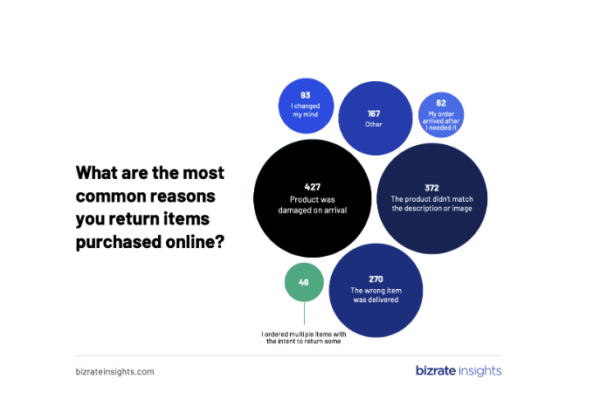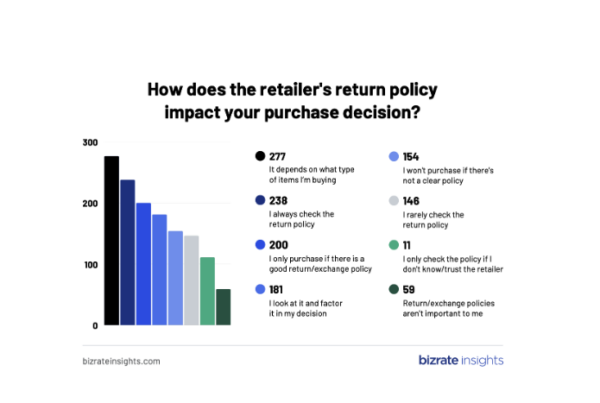Will Ramos· Author
Why It’s Vital to Factor Returns into Your Ecommerce Business Metrics
The return policies of ecommerce platforms aren’t just a functional aspect of online shopping – they are a crucial part of the consumer experience and can significantly impact business performance. In a competitive ecommerce landscape, understanding and catering to why customers return products can be a game-changing strategy. It influences customer loyalty, brand reputation, and ultimately, the bottom line.
Bizrate Insights surveyed 1,050 verified shoppers to collect insight into how the returns process affects their shopping experience, buying behavior, and sentiment. Here’s what we learned:

The data skews slightly by gender – showing a higher reluctance in men to engage in the returns process. That said, a majority of customers are quite selective in making returns. 44.96% of participants claim they hardly ever return items, while 33.81% rarely do so. Only a minimal 2.21% claim to return items frequently. While these are broad insights and consumer behavior might vary in your vertical or on your ecommerce store specifically, most consumers do not want to waste the retailer’s time and money with spurious returns.
Which brings us to the next question – why do customers return products?
Understanding the Reasons Why Customers Return Goods
The leading cause for returns, selected 425 times, is receiving a damaged product. The disconnect between expectation and reality is the second most common reason, with 372 mentions of returning items that didn’t match the online description or image. Misdeliveries also contribute to the return statistics.

These insights emphasize the need for quality control, accurate product representation, and meticulous delivery processes to mitigate return instances.
How Your Return Policy Influences Consumer Behavior
Our consumer survey shed light on the intrinsic role of a clear, favorable return policy in shaping consumer decisions. A clearly stated return policy is not an afterthought but a pivotal factor swaying purchase decisions. Out of 1,050 respondents, only 59 said they don’t factor a return policy into their buying decision. The answer “I won’t purchase if there’s no clear return policy” was selected 154 times, and the answer “I only purchase if there is a good return policy” got 200 votes. Additionally, “I always check the return policy” got 238 votes. When reviewing why customers return products, it becomes evident that a clear, transparent, and accommodating return policy is no longer optional but necessary in today’s ecommerce landscape.

Preferred Return Processes
How your company facilitates returns can enhance or dampen the customer experience. According to our data, a whopping 65.20% of consumers prefer returning items via pre-paid shipping labels. The convenience and cost-effectiveness of this method appeals to the modern shopper. Giving customers easy access to a printable return label would help those who need to return an item, as they wouldn’t have to wait for a label to be emailed or shipped.

Tailoring return processes to diverse customer preferences can be the subtle difference setting a brand apart.
FAQs About Customer Return Behavior
Here are some common questions we get about why customers return products.
What Is the Significance of Understanding Customer Return Behaviors in Ecommerce?
Understanding why customers return products is significant in ecommerce because it shows how your business is doing. Yes, you can measure your business success through profits and inventory movement, but returns are an underutilized measurement.
For example, if your products are consistently showing up broken or customers are getting the wrong items, those issues will affect business. You’ll lose your good reputation through poor online reviews, and people will trust your company less, resulting in lost sales. If you’re aware of this issue, you can take steps to correct it, preventing recurrence and helping to attract new customers through an improved reputation.
What Are the Most Common Reasons Why Customers Return Goods Purchased Online?
The most common reasons why customers return goods purchased online are:
- Damaged products
- The product doesn’t match the description
- Misdeliveries
How Can an Ecommerce Store Enhance the Return Process for Customers?
An ecommerce store can enhance the return process for its customers by taking the following steps:
- Offering pre-paid shipping labels
- Giving clear return instructions and guidelines
- Simplifying the return request process
- Ensuring timely refunds or replacements
- Collecting customer feedback to improve the experience
What Are Some Best Practices for Creating a Clear and Transparent Return Policy?
The best practices for creating a clear and transparent return policy are:
- Making the return window clear
- Listing out acceptable return conditions
- Outlining the return process step-by-step
- Providing contact information for customer support
- Using plain language
What Are Some Common Challenges Ecommerce Businesses Face in Managing Returns, and How Can They Overcome Them?
Some common challenges ecommerce businesses face in managing returns are:
- Impact on profits
- High shipping costs
- Return fraud
- Product condition disputes
- Processing issues
Proactivity can help your ecommerce store overcome these concerns. If you have high shipping costs, negotiate lower rates with your carrier. You can deal with fraud by implementing detection measures.
When improving your return guidelines, clarify what condition products should be in to qualify as returnable. Even better, add photos to the policy.
If pricing is a problem, optimize your inventory and pricing strategies. You can improve managing your returns by using automation to streamline return workflows.
How Can Ecommerce Stores Effectively Observe and Analyze Return Trends to Optimize Their Policies?
Ecommerce stores can analyze return patterns by collecting and utilizing in-depth data from verified customers’ direct feedback. You can also use ecommerce analytics to better track and understand return data and look at seasonal patterns or product-specific returns.
Once you have this information, you can alter your return policy and process to improve profits.
Get Insights into Your Consumers’ Behavior Trends
As ecommerce continues to evolve, refining return policies and processes is indispensable. The meticulous observation of return trends, backed by data, can lead to enhanced customer satisfaction, reduced return rates, and increased profitability.
While traditional views of returns used to focus mainly on logistics, the modern ecommerce entrepreneur sees returns as an integral aspect of the overall customer journey. Every return is an opportunity for interaction, an opening to solidify trust, enhance brand reputation, and cement customer loyalty.
As business leaders, aligning with the dynamic needs and expectations of customers, understanding why customers return products, and optimizing return policies for convenience and clarity is a strategic imperative.
To navigate this complex yet rewarding landscape, insights rooted in data are your compass. Bizrate Insights is your partner in this journey, offering nuanced, data-driven perspectives on consumer behavior and sentiment. Our in-depth consumer feedback from verified customers empowers you to transform every return into a strategic interaction, enhancing shopper satisfaction and loyalty.
Stop guessing in the dark. Leverage the power of insights, turn data into action, and transform returns into strategic opportunities for enhanced customer engagement and business growth.
Reach out to Bizrate Insights today. Because every customer experience counts.